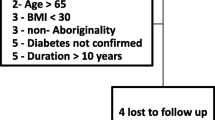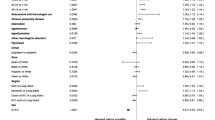Abstract
Background
Gastric banding has been promoted as less suitable for indigenous persons or persons who live remotely as it requires in person follow-up for band adjustment and may have higher rates of reoperation. This study assessed being an indigenous Australian or living remotely (but not both) on outcomes following gastric banding.
Methods
Data was prospectively recorded on all 559 patients who underwent gastric banding by one surgeon at one private hospital in Darwin, between February 1998 and August 2014.
Results
Forty persons (7 %) were indigenous and 93 (17 %) were remotely living (only 7 were both). At the last assessment (follow-up 37 (SD 31) months), overall percentage of excess weight loss (EWL) was 53 % (30 %), the percentage of total weight loss (TWL) was 23 (13), and 389 (70 %) achieved >50 % EWL. Seventy-two percent (43/60) ceased all diabetic medications. Ninety-two (17 %) came to reoperation. There was little difference between the indigenous and non-indigenous metropolitan-living groups, or between the remote and metropolitan non-indigenous groups in %EWL, %TWL, the proportion who achieved more than 50 % EWL, the time to achieve the goal weight, or cessation of diabetes medication. Similarly, there was little difference in the time to band removal or replacement. No person was directly compromised at band removal/replacement by delay due to dwelling remotely.
Conclusions
In these select persons who underwent gastric banding in the private sector only, outcomes of weight loss and revisional surgery were acceptable and comparable between indigenous and non-indigenous metropolitan-dwelling persons as well as between remote and metropolitan-dwelling non-indigenous persons.



Similar content being viewed by others
References
Australian Institute of Health and Welfare [PDF on Internet]. Australia’s Health 2014. Australian Government, Canberra: Commonwealth of Australia, [updated 25 June 2014, cited 11 July 2014] Available from: http://www.aihw.gov.au/WorkArea/DownloadAsset.aspx?id=60129547575.
Australian Bureau of Statistics [Internet]. Australian Aboriginal and Torres Strait Islander Health Survey: First Results, Australia, 2012–13. (ABS Cat. No. 4727.0.55.001). Australian Government, Canberra: Commonwealth of Australia, [updated 27 November 2013, cited 11 July 2014]. Available from: http://www.abs.gov.au/ausstats/abs@.nsf/mf/4727.0.55.001.
Treatment of obesity in adults. Council on Scientific Affairs. JAMA. 1988;260(17):2547–51. Review. PMID: 3050181.
Australian Government Department of Health [Internet]. Obesity Review 2011. Australian Government, Canberra: Commonwealth of Australia, [Updated 1 June 2011, cited 1 March 2014). Available from: https://www.health.gov.au/internet/main/publishing.nsf/Content/Obesity_+Review.
Colquitt JL, Picot J, Loveman E, Clegg AJ. Surgery for obesity. Cochrane Database of Systematic Reviews 2009, Issue 2. Art. No.: CD003641. DOI: 10.1002/14651858.CD003641.pub3. Cochrane Database Syst Rev. 2009;2:CD003641. doi:10.1002/14651858.CD003641.pub3. PMID: 19370590, Review.
van Rutte PWJ, Smulders JF, de Zoete JP, Nienhuijs SW. Outcome of sleeve gastrectomy as a primary bariatric procedure. Br J Surg. 2014;101(6):661–8. doi:10.1002/bjs.9447. PMID: 24723019.
Clinical Issues Committee ASMBS. Updated position statement on sleeve gastrectomy as a bariatric procedure. Surg Obes Relat Dis. 2012;8(3):e21–6. doi:10.1016/j.soard.2012.02.001. PMID: 22417852.
Rosenthal RJ. International Sleeve Gastrectomy Expert Panel, et al. International Sleeve Gastrectomy Expert Panel Consensus Statement: best practice guidelines based on experience of > 12,000 cases. Surg Obes Relat Dis. 2012;8(1):8–19. doi:10.1016/j.soard.2011.10.019. PMID: 22248433.
National Health and Medical Research Council, 2013[PDF on Internet]. Clinical Practice Guidelines for the management of overweight and obesity in adults, adolescents and children in Australia. Australian Government, Canberra: Commonwealth of Australia, [Updated October 2013, Cited 11 July 2014]. Available from: http://www.nhmrc.gov.au/_files_nhmrc/publications/attachments/n57_obesity_guidelines_131204_0.pdf.
Reinhold RB. Critical analysis of long term weight loss following gastric bypass. Surg Gynecol Obstet. 1982;155(3):385–94.
Toouli J, Kow L, Ramos AC, Aigner F, Pattyn P, Galvão-Neto MP, et al. International multicenter study of safety and effectiveness of Swedish Adjustable Gastric Band in 1-, 3-, and 5-year follow-up cohorts. Surg Obes Relat Dis. 2009;5(5):598–609. doi:10.1016/j.soard.2009.04.012. PMID: 19656740.
Brethauer SA, Kim J, El Chaar M, Papasavas P, Eisenberg D, Rogers A, et al. ASMBS Clinical Issues Committee. Standardized outcomes reporting in metabolic and bariatric surgery. Obes Surg. 2015;25(4):587–606. doi:10.1007/s11695-015-1645-3.
Hoy WE, Kondalsamy-Chennakesavan S, Wang Z, Briganti E, Shaw J, Polkinghorne K, et al. AusDiab Stud y Group. Quantifying the excess risk for proteinuria, hypertension and diabetes in Australian Aborigines: comparison of profiles in three remote communities in the Northern Territory with those in the AusDiab study. Aust N Z J Public Health. 2007;31(2):177–83. PMID: 17461011.
Australian Diabetes Association. Bariatric Surgery Position Statement [PDF on Internet]. Sydney: Australia, [updated April 2014; cited 11 July 2014]. Available from: http://www.australiandiabetescouncil.com/ADCCorporateSite/files/58/58103fe2-9871-4eda-842a-eb42151b2c61.pdf.
International Diabetes Federation [PDF on Internet]. Bariatric Surgical and Procedural Interventions in the Treatment of Obese Patients with Type 2 Diabetes. Position Statement.. Brussels, Belgium. [Updated 28 March 2011, cited 11 July 2014] Available from: http://www.idf.org/webdata/docs/IDF-Position-Statement-Bariatric-Surgery.pdf.
Korda RJ, Joshy G, Jorm LR, Butler JR, Banks E. Inequalities in bariatric surgery in Australia: findings from 49,364 obese participants in a prospective cohort study. Med J Aust. 2012;197(11):631–6. PMID: 23230934.
Australian Institute of Health and Welfare [PDF on Internet]. Improving the accessibility of health services in urban and regional settings for Indigenous people 2014. Australian Government, Canberra: Commonwealth of Australia, [updated 1 December 2013, cited 28 June 2015] Available from: http://www.aihw.gov.au/uploadedFiles/ClosingTheGap/Content/Publications/2013/ctgc-rs27.pdf.
Lukas N, Franklin J, Lee CMY, Taylor CJ, Martin DJ, Kormas N, et al. The efficacy of bariatric surgery performed in the public sector for obese patients with comorbid conditions. Med J Aust. 2014;201:21–2.
Sudan R, Winegar D, Thomas S, Morton J. Influence of ethnicity on the efficacy and utilization of bariatric surgery in the USA. J Gastrointest Surg. 2014;18(1):130–6. doi:10.1007/s11605-013-2368-1.
Mainous 3rd AG, Johnson SP, Saxena SK, Wright RU. Inpatient bariatric surgery among eligible black and white men and women in the United States, 1999–2010. Am J Gastroenterol. 2013;108(8):1218–23. doi:10.1038/ajg.2012.365.
Worni M, Guller U, Maciejewski ML, Curtis LH, Gandhi M, Pietrobon R, et al. Racial differences among patients undergoing laparoscopic gastric bypass surgery: a population-based trend analysis from 2002 to 2008. Obes Surg. 2013;23(2):226–33. doi:10.1007/s11695-012-0832-8.
Bayham BE, Bellanger DE, Hargroder AG, Johnson WD, Greenway FL. Racial differences in weight loss, payment method, and complications following Roux-en-Y gastric bypass and sleeve gastrectomy. Adv Ther. 2012;29(11):970–8. doi:10.1007/s12325-012-0062-4.
Varela JE, Nguyen NT. Disparities in access to basic laparoscopic surgery at U.S. academic medical centers. Surg Endosc. 2011;25(4):1209–14. doi:10.1007/s00464-010-1345-y.
Wallace AE, Young-Xu Y, Hartley D, Weeks WB. Racial, socioeconomic, and rural–urban disparities in obesity-related bariatric surgery. Obes Surg. 2010;20(10):1354–60. doi:10.1007/s11695-009-0054-x.
Jackson TD, Zhang R, Glockler D, Pennington J, Reddigan JI, Rotstein OD, et al. Health inequity in access to bariatric surgery: a protocol for a systematic review. Syst Rev. 2014;3:15. doi:10.1186/2046-4053-3-15. Review.
Old OJ, Egan RJ, Norton SA, Morgan JD. Ethnic minorities have equal access to bariatric surgery in the UK and Ireland. Obes Surg. 2013;23(5):727–9. doi:10.1007/s11695-013-0904-4.
Lam EC, Murariu D, Takahashi E, Park CW, Bueno RS, Lorenzo CS. Prescription drug cost reduction in Native Hawaiians after laparoscopic Roux-en-y gastric bypass. Hawaii J Med Public Health. 2013;72(2):40–3.
Parikh M, Lo H, Chang C, Collings D, Fielding G, Ren C. Comparison of outcomes after laparoscopic adjustable gastric banding in African-Americans and whites. Surg Obes Relat Dis. 2006;2(6):607–10. discussion 610–2.
Phoenix GK, Penney N, Cocker DM, Davies A, Smellie J, Bonanomi G, et al. Comparison of weight loss achieved after laparoscopic adjustable gastric banding between Afro-Caribbean, Caucasian and South Asian adult female patients in a London bariatric centre. Ann R Coll Surg Engl. 2013;95(5):335–40. doi:10.1308/003588413X13629960045995.
Khorgami Z, Arheart KL, Zhang C, Messiah SE, de la Cruz-Muñoz N. Effect of ethnicity on weight loss after bariatric surgery. Obes Surg. 2015;25(5):769–76. doi:10.1007/s11695-014-1474-9.
Ng J, Seip R, Stone A, Ruano G, Tishler D, Papasavas P. Ethnic variation in weight loss, but not co-morbidity remission, after laparoscopic gastric banding and Roux-en-Y gastric bypass. Surg Obes Relat Dis. 2015;11(1):94–100. doi:10.1016/j.soard.2014.07.013.
Coleman KJ, Brookey J. Gender and racial/ethnic background predict weight loss after Roux-en-Y gastric bypass independent of health and lifestyle behaviors. Obes Surg. 2014;24(10):1729–36. doi:10.1007/s11695-014-1268-0.
Admiraal WM, Celik F, Gerdes VE, et al. Ethnic differences in weight loss and diabetes remission after bariatric surgery a meta-analysis. Diabetes Care. 2012;35(9):1951–8.
Seeleman C, Sellenger V, Essink-Bot M-L, et al. Teaching communication with ethnic minority patients: ten recommendations. Med Teach. 2011;33(10):814–9.
American Society for Metabolic and Bariatric Surgery [Internet] Gainesville, FL. Benefits of Bariatric Surgery [Cited 27 June 2015] Available from: http://asmbs.org/patients/benefits-of-bariatric-surgery.
Mechanick JI et al. American Association of Clinical Endocrinologists, The Obesity Society, and American Society for Metabolic & Bariatric Surgery. Medical Guidelines for Clinical Practice for the perioperative nutritional, metabolic, and nonsurgical support of the bariatric surgery patient. Surg Obes Relat Dis. 2008;4(5 Suppl):S109–84.
International Federation for the Surgery of Obesity and Metabolic Disorders [Internet]. Treatment Options. [Cited 10 October 2015] Available from: http://www.ifso.com/treatment-options.
Buchwald H, Avidor Y, Braunwald E, Jensen MD, Pories W, Fahrbach K, et al. Bariatric surgery: a systematic review and meta-analysis. JAMA. 2004;292(14):1724–37. doi:10.1001/jama.292.14.1724.
Heinberg LJ, Keating K, Simonelli L. Discrepancy between ideal and realistic goal weights in three bariatric procedures: who is likely to be unrealistic? Obes Surg. 2009;20(2):148–53.
White MA et al. Do patients’ unrealistic weight goals have prognostic significance for bariatric surgery? Obes Surg. 2007;17(1):74–81.
Foster GD et al. Obese patients’ perceptions of treatment outcomes and the factors that influence them. Arch Intern Med. 2001;161(17):2133–9.
Foster GD et al. What is a reasonable weight loss? Patients’ expectations and evaluations of obesity treatment outcomes. J Consult Clin Psychol. 1997;65(1):79–85.
Provencher V et al. Defined weight expectations in overweight women: anthropometrical, psychological and eating behavioral correlates. Int J Obes (Lond). 2007;31(11):1731–8.
Byrne SM. Psychological aspects of weight maintenance and relapse in obesity. J Psychosom Res. 2002;53(5):1029–36.
Dalle Grave R et al. Weight loss expectations in obese patients and treatment attrition: an observational multicenter study. Obesity Res. 2005;13(11):1961–9.
Cooper Z, Fairburn CG. A new cognitive behavioural approach to the treatment of obesity. Behav Res Ther. 2001;39(5):499–511.
Rothman AJ. Toward a theory-based analysis of behavioral maintenance. Health Psychol. 2000;19(1 Suppl):64–9.
Price HI1, Gregory DM, Twells LK. Weight loss expectations of laparoscopic sleeve gastrectomy candidates compared to clinically expected weight loss outcomes 1-year post-surgery. Obes Surg. 2013 Dec;23(12):1987–93. doi: 10.1007/s11695-013-1007-y
Nimeri A, Ibrahim M, Maasher A, Al Hadad M. Management algorithm for leaks following laparoscopic sleeve gastrectomy. Obes Surg. 2015 Jun 13. [Epub ahead of print]
Royal Australasian College of Surgeons [Internet]. Guidelines and Position Papers. Fellowships and Standards. Obesity Surgery Training and Experience Position Paper. References FES_FEL_005. Melbourne, Australia. [Updated June 2009, Cited 11 July 2011] Available from: http://www.surgeons.org/policies-publications/publications/position-papers.
Acknowledgments
Conflict of Interest
The authors declare that they have no conflict of interest.
Ethical Approval
This article does not contain any studies with human participants or animals performed by any of the authors. For this type of retrospective study, formal consent was not required. The study was approved by the Joint Ethics Committee of the Menzies School of Health Research and the Royal Darwin Hospital (HREC 2014–2250).
Grant information and grant support
No grant support.
Author information
Authors and Affiliations
Corresponding author
Rights and permissions
About this article
Cite this article
Treacy, P.J., Chatfield, M.D. & Bessell, J. Is Gastric Banding Appropriate in Indigenous Or Remote-Dwelling Persons?. OBES SURG 26, 1728–1734 (2016). https://doi.org/10.1007/s11695-015-1993-z
Published:
Issue Date:
DOI: https://doi.org/10.1007/s11695-015-1993-z




